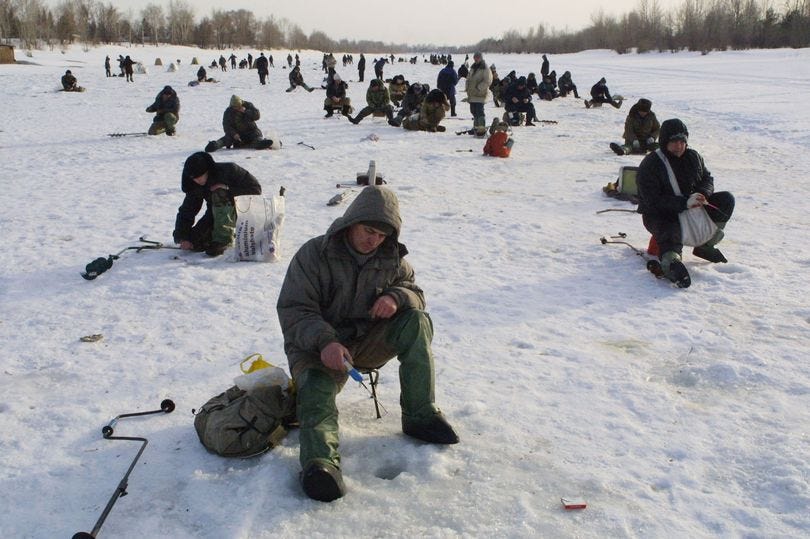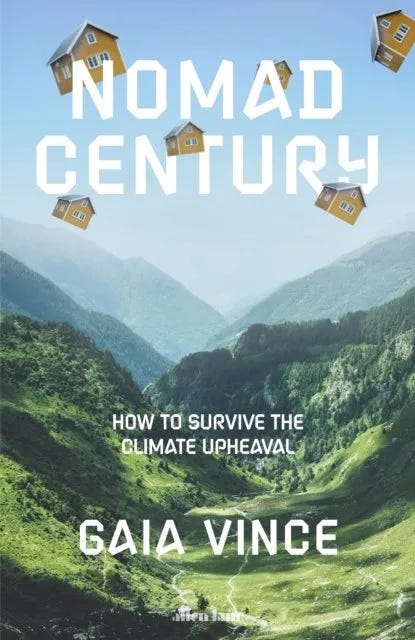Review: Nomad Century by Gaia Vince
Are we prepared to move home, community and country to survive climate breakdown?

The following by yours truly is based on a review that appeared in the Times Literary Supplement (TLS) November, 2022.
Have you decided where to migrate to when your home, farm, community or city are destroyed by climate breakdown?
That was a challenge faced by approximately 30 million Pakistani citizens in August, 2022. Displaced by the catastrophic flooding of the Indus river, caused by melting Himalayan glaciers, their search for new, safer homes and farmland, looked bleak.
For those millions, and for many millions more, Gaia Vince in Nomad Century provides a guide to potentially liveable cities – many on the fringes of the Arctic.
These include places like Nuuk, the capital city of Greenland. Thanks to global warming, the melting of Greenland’s ice sheet - the largest on earth after Antarctica - is accelerating. In Greenland’s case, VInce explains optimistically, the impact is positive, as the melting ice will expose new areas and land for people “to live, farm and mine minerals.”
Other destinations recommended include the small coastal town of Höfn in south eastern Iceland, and Churchill in Manitoba, Canada, a “barren outpost, wedged between boreal forest, Arctic tundra and Hudson Bay”.
Then there is the Cossack city of Yakutsk, the capital of the Republic of Sakha, Siberia, and “the largest city built on continuous permafrost”. There, once thawed bogs stabilize, the “landscape will be exploitable for drainage, construction or agriculture”. Buried below the Arctic ice there is useful agricultural soil and land to build cities on, Vince assures us, which will allow the development of “a hub of connected Arctic cities.”
She warns Americans that worsening tornadoes, heatwaves, wildfires and drought will make whole swathes of their country problematic for 330 million citizens. The nation stands to lose half its maize crop including most of the current-day Corn Belt, she argues.
This has implications for us all.
Along with Brazil and Ukraine, the US accounts for nearly 90 per cent of food exports, so a 4C rise in global temperature would slash harvests and exports to the rest of the world. Flooding, erosion and the fouling of freshwater will make desirable locations like Florida, California and Hawaii unlivable. Instead, Vince argues, mass migration north will ensure the declining Rust Belt cities will experience a renaissance, as a globally diverse community of new immigrants revitalizes them all.
To estimate likely migration numbers Vince cites a team of scientists writing in the Proceedings of the National Academy of Sciences. They have estimated that up to three billion people will have to leave their homes by 2050. So far, there is no evidence of any planning by international institutions and national governments for such a mass movement. Hence Vince’s ambitious, well-researched and wide-ranging book: a science writer’s urgent plea for policy-makers to grasp the inevitability of mass migration, plan for it, and devise and implement appropriate policies.
Throughout Nomad Century, she sets out to frame such preparation as of immense economic benefit to host countries.
Vince presents readers with considerable evidence that even large waves of low-skilled migrants have no negative impact on the wages or employment prospects of the native population – and often have a positive impact. The National Bureau of Economic Research reports that US counties that welcomed large numbers of immigrants between 1860 and 1920 for example, led to a 57 per cent average increase in manufacturing output per capita by 1930 and up to a 58 per cent increase in agricultural farm values. Average incomes were 20 per cent higher relative to counties with no immigration flows, with improved education attainment, and lower unemployment and poverty rates by 2000.
This evidence is widely accepted by economists and is convincing. But while Vince is a distinguished science writer, her predictions and hopes for mass migration in the future reveal a profound contradiction in the case she makes.
Trillion Dollar Bills Lying on the Sidewalk?
Migration, she asserts, must not be feared as it will boost GDP, which is to say it will increase economic activity and output. In a section titled “Trillion Dollar Bills Lying On the Sidewalk” she cites World Bank evidence to show that If rich countries increased their population by just 3 per cent through immigration, they would boost global GDP (economic output) by over $365 billion in less than a decade. The lead researcher, Michael Clemens, said that there were effectively ‘trillion dollar bills lying on the sidewalk’ to be picked up if borders were all opened.
However, as many environmentalists and ecologists have argued, capitalism’s ‘growth’ dynamic is itself the cause of climate breakdown.
Our economic history makes clear that “we” and our economic policies “are the asteroid” that triggers mass migration. This is because ‘growth’ under capitalism implies the almost exponential expansion of economic activity and finds expression in the term GDP – a measure of the market value of all the final goods and services produced over specific times.
The expectation is that GDP must and always will “grow”. Central to the expansion of economic activity is the exploitation and extraction of the planet’s precious, and finite assets - used to fuel ‘growth’ and the accumulation of profits. These activities are the very drivers that have led to the release of tonnes of carbon into the atmosphere. They in turn have triggered climate breakdown and ecological degradation.
One consequence, as Vince is at pains to explain, is mass migration away from degraded environments. Vince’s argument therefore that migration will lead to more of the same forces of extractive capitalism is a contradiction in terms. The case for the benefits (including, simply, survival) from mass migration stand without the need for the imperative that is ‘growth’ or “to scatter trillion dollar bills on the sidewalk.”
Vince’s strength is her positive approach to the topic of migration. However, her idealism leads to the glib assertion that flexible borders and global mobility can and “must be managed at the global level” even as she complains of the “decadal erosion in the powers of global bodies, from our failure to act on greenhouse gas emissions to our failure to vaccinate the global south against Covid”.
There are sound democratic reasons for building decision-making closer to home – and not in remote and unaccountable global institutions. She ignores that truism, and proposes a
“Global UN Migration Organization with real power to compel governments to accept refugees (my emphasis)… to agree a sensible plan for the redistribution of people whose circumstances are becoming harder … and to manage both the immediate and long-term strategy of relocation, remuneration, funding and potentially, returns”.
That compulsion is bound to meet resistance and to be counter-productive. And given the current impotence and stalemate of the UN Security Council, such optimism comes across as naïve. Instead, what is needed is sound international leadership by those most responsible for climate breakdown, notably the US; leadership based on international cooperation and coordination, not compulsion.





"That compulsion is bound to meet resistance and to be counter-productive. And given the current impotence and stalemate of the UN Security Council, such optimism comes across as naïve..." ((( It is naïve unless sufficient nations end the Security Council with a UN Mk2 )))
"... .Instead, what is needed is sound international leadership by those most responsible for climate breakdown, notably the US; leadership based on international cooperation and coordination, not compulsion. ((( Assuming that the US; goes with their normal compulsion and associated short termist voting requirements the situation gets worse fastest.
A radically changed UN could effectively win #DeliberativeDemocracy worldwide starting with the most local of #CitizensAssemblies as is increasingly found in Europe. How? Because they can he seen to work if not sabotaged by politics as normal. The larger the decision then the more important for proper security agency vetting of all participants. This might have a delay to its transparency? That allows people to step back away from transparency?
If the CAs are kept independent, transparent and binding (if CA decisions are not implemented then the authorities are perhaps not re-elected at next elections by democracy only)
It then works or not . If they don't then it's likely corruption of process hense the transparency... If it's a systemic flaw then it het fixed or people revert to politics as failing normal or move anew.
Previously the fixers of the UK Climate Assembly and Scottish Assembly where government contractors They made the decisions to who the "experts" to be listened to were.
To solve assembly members receive critical thinking training first. They her time to check their training and amend it. They then decide their own experts witnesses and government either makes it work or gets changed or not via democracy.
Business likes it because it's not short termism. Team Xi hates it because it's not short termism...
It also gets to make many more best decisions than top down structures because it's everyday people very many times over on normal pay